Optics and Photonics Journal
Vol.2 No.1(2012), Article ID:18283,5 pages DOI:10.4236/opj.2012.21008
Photon Correlation Spectroscopy and SAXS Study of Mixture of NaCl with AOT Microemulsion at X = 6.7
Department of Physics, University of Sistan and Baluchestan, Zahedan, Iran
Email: *soheil.sharifi@gmail.com, sharifi@df.unipi.it
Received January 15, 2012; revised February 14, 2012; accepted February 24, 2012
Keywords: Nano-size; droplet; Microemulsions; Photon Correlation Spectroscopy; SAXS; Diffusion
ABSTRACT
Photon Correlation Spectroscopy is used to study the AOT microemulsion with and without NaCl. Collective diffusion coefficient was investigated by Photon Correlation Spectroscopy technique. We have studied effect of charge on dynamic of water-in-oil microemulsion (nano-droplet of water to the oil), which stabilized by AOT and dispersed in n-Decane at water/AOT with 6.7 molar ratio. The small angle X-ray scattering technique and hard sphere model were used to study the structural information of AOT microemulsion with and without NaCl. The structural investigation of samples shows a decrease of length scale of cylindrical droplets with increasing of NaCl concentration in AOT microemulsion.
1. Introduction
The microemulsions are consisting nano-meter size of water droplets in the oil [1-3]. Microemulsion have attracted interest for the delivery of single drug substances with low water solubility and stabilization of drugs in combination due to their preferential solubility in either the water or oil phases [4,5]. Microemulsions can be regarded as reverse-micellar solutions that have solubilized water into the polar surfactant tail region (L2 phase). The anionic surfactant Aerosol OT (sodium bis-(2-ethylhexyl) sulfosuccinate, AOT) together with water and oil readily forms ternary microemulsions. The aqueous part of microemulsion is usually water or a solution of water with salts. The dynamic properties of microemulsions and colloidal systems are studied by photon correlation spectroscopy (PCS) [6-8] and the structure of AOT microemulsions are well investigated at water to the surfactant molar ration 6.7 [9]. A study shown, for AOT/H2O/ Decane microemulsion, at the low droplet mass fractions (0.01< mf <0.1 and molar ratio 40) the collective diffusion coefficient has a linear behavior as function of the mass fraction [10]. It is well known that at high water concentration with a water to surfactant molar ratio of X = 40 the collective diffusion coefficient Dc depends on the droplet mass fraction (droplet concentration) due to inter-particle interactions [10]. This study is an attempt to understand the collective diffusion coefficient of AOT/ H2O/Decane microemulsion at low water concentration X = 6.7 construct with photon correlation spectroscopy.
Our previous work on AOT microemulsion at 6.7 shows a spherical to cylindrical transition [9]. In the present work, we studied the behavior of the collective diffusion coefficient (Dc) at the fix water to oil ratio (X = 6.7) and low mass fraction, by means of photon correlation spectroscopy and SAXS techniques. Moreover, we study the effect of NaCl on the Dc and structure of the AOT/H2O/ Decane microemulsion.
2. Experimental
Photon Correlation Spectroscopy measurements were performed using an ALV single-detector version compact goniometer system, from ALV-GmbH, Langen, Germany. The light source is a He-Ne laser, operating at a wavelength of 632.8 nm with vertically polarized light. The beam was focused on the sample cell through a temperature-controlled cylindrical quartz container (with two plane-parallel windows), which is filled with a refractive index matching liquid (toluene). All the correlation functions in this work were fitted by a single stretched exponential function [10-13].
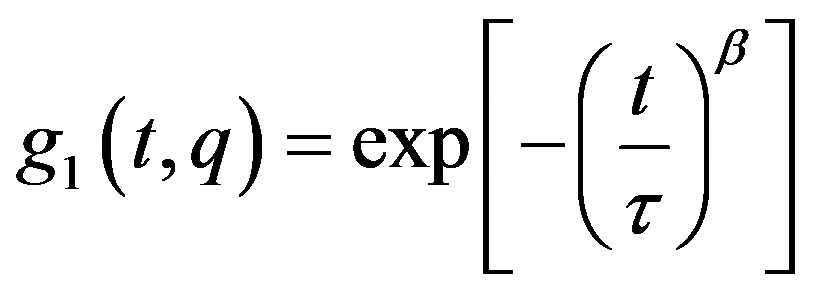 (1)
(1)
The stretched exponential function describes the decay processes that have a distribution of relaxation times (τ). The parameter β (0 ≤ β ≤ 1) shows width of the distribution function. Small-angle X-ray scattering (SAXS) measurements were performed using the pinhole SAXS instrument at the Aarhus [14]. The instrument consists of an X-ray camera (NanoSTAR, Bruker AXS) with a rotating anode X-ray (Cu Kα radiation) source, cross-coupled Göbel mirrors, collimation using three pinholes, an evacuated beam path, and a 2D position-sensitive gas detector (HiSTAR). The experiments were done at a fixed wavelength of λ = 1.54 Å and two different sample-detector distances. In the current experiments small pinholes were used, giving a range of scattering vectors as 0.004 < q(1/Å) < 0.2, (q = 4πsinθ/λ where θ is half the scattering angle.
n-Decane, NaCl and Sodium-2-diethylhexyl sulfosuccinate, or AOT 99% were obtained from Sigma-Aldrich. Chemicals were used as received and MilliQ water was used in preparing all samples. The bottles of AOT, which are hermetically sealed, have always been stored in a refrigerator well below the melting point (23˚C). After a container was opened, the surfactant was stored in a nitrogen environment; it was still found that the surfactant did not remain stable for more than a month. The samples were prepared by mixing the components directly in glass ampoule in order to minimize the number of transfers and the glass ampoules were tightly sealed with a gas flame. The composition of each system is determined by the molar ratio X of water to surfactant molecules, X = [H2O]/[AOT] where [H2O] and [AOT] are molarities of water and surfactant. The droplet mass fraction mf = (mAOT + mH2O)/(mAOT + mH2O + mDec) Which varies by the respective mass of the components water (mH2O), decane (mDec), and AOT(mAOT). The microemulsions were prepared by weight, in terms of X = 6.7 and the different mass fraction of droplets (mf,drop = (mH2O + mAOT)/(mDec + mH2O + mAOT)), which varies by the respective mass of n-decane (mDec), AOT(mAOT). The samples were thoroughly shaken to ensure homogenization and then kept at the temperature 20˚C in a water bath for several days before the experiment. We observed that all samples were transparent at 20˚C. The mixing of NaCl with microemulsions is described by molar ratio of NaCl to AOT, Y = [NaCl]/[AOT], for this experiments, Y = 0.005.
3. Results and Discussion
Microemulsions were formulated by mixing AOT with water and n-Decane at constant molar ratio of water to AOT (X = 6.7) at the different mass fraction (0.01 < mf < 0.3 dilute regime).
Dynamic behavior of the AOT/H2O/Decane microemulsion was probed with photon correlation spectroscopy. The correlation function shows a single stretch exponential decay at all concentrations, figure 1. The AOT/ H2O/Decane/NaCl microemulsion at X = 6.7 and [NaCl]/ [AOT] = 0.005 and different mass fraction is studied by photon correlation spectroscopy, figure 2.
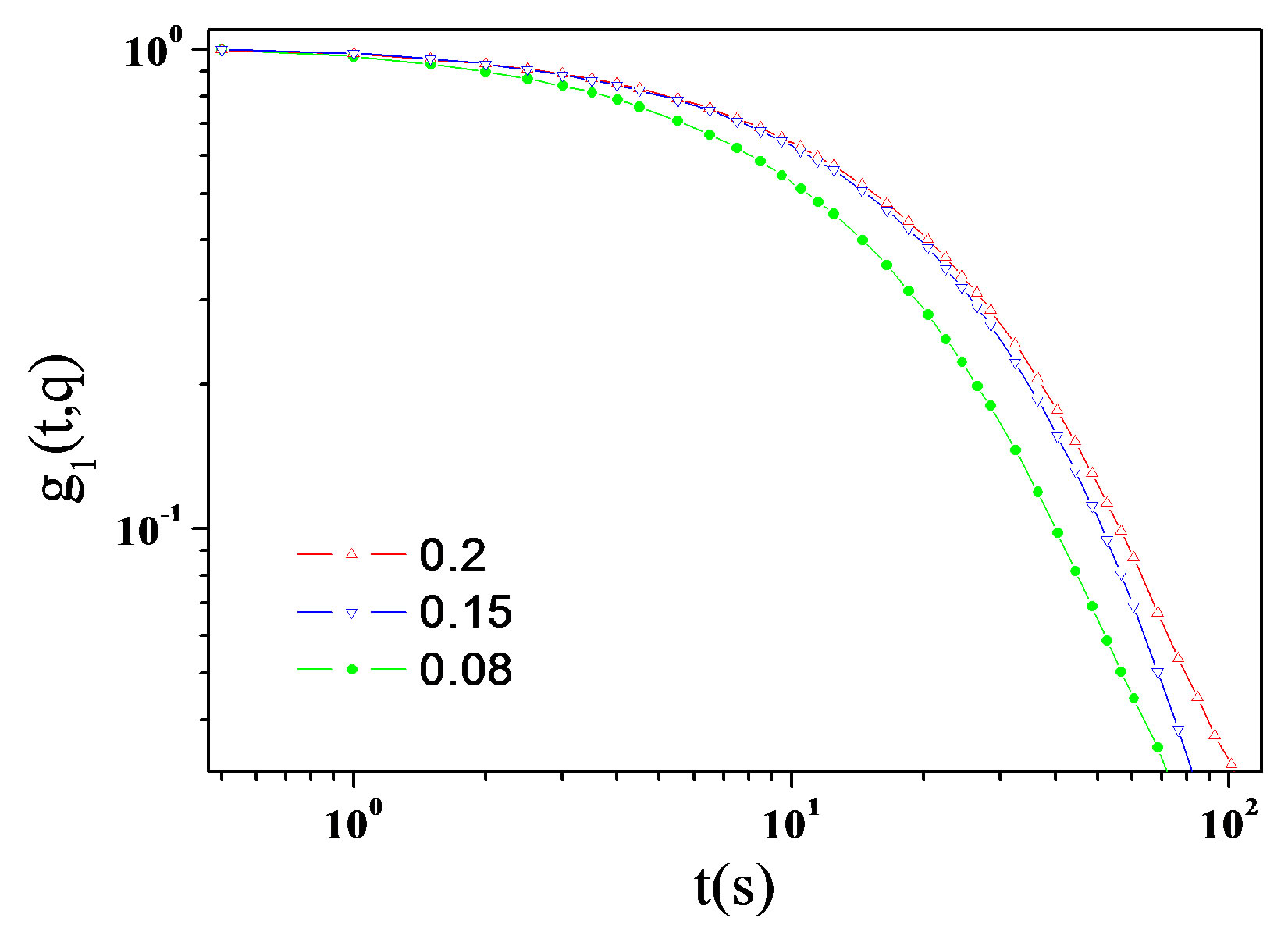
Figure 1. Correlation function as function delay time for AOT/H2O/Decane microemulsion at X = 6.7 and different mass fraction at 20˚C.
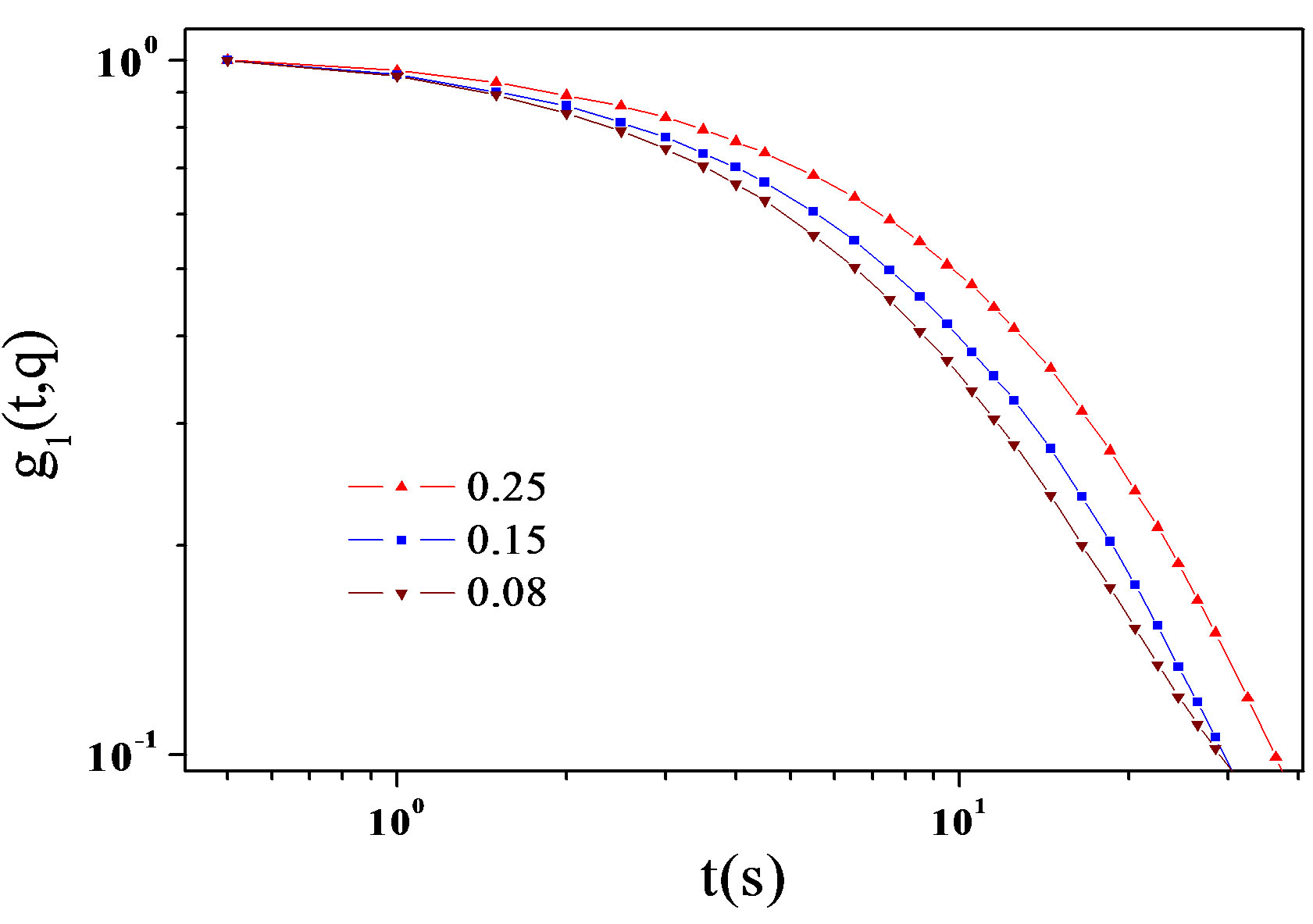
Figure 2. Correlation function as function delay time for AOT/H2O/Decane/NaCl microemulsion at X = 6.7 and [NaCl]/[AOT] = 0.005, and different mass fraction at 20˚C.
All the correlation functions in this work were fitted by a single stretched exponential function, equation (1). The collective diffusion coefficient Dc were extracted from Dc = 1/q2<τ> as the function of the mass fraction for the AOT/H2O/Decane and AOT/H2O/Decane/NaCl microemulsion illustrated in figure 3. The normalized collective diffusion coefficient show a liner behavior with negative slop between 0.01 < mf < 0.75. Our results show after adding NaCl to the AOT/H2O/Decane microemulsion, diffusion increase clearly, figure 3.
In this work, SAXS is used for the determination of the structure of AOT/H2O/Decane microemulsions at 293.15 K. The SAXS method was used because the scattering of X-rays of wavelengths of a few angstroms through small angles provides a q range which is particularly appropriate for the determination of both the size of discrete reverse micelles and their interactions. The scattered intensity as a function of q for AOT/ H2O/Decane and AOT/H2O/Decane/NaCl microemulsion is presented in the figure 4, which the lines are fits to a power law, I(q) ≈ q−1, with properties of a cylindrical object. At small q, the scattering is only sensitive to the

Figure 3. The normalized collective diffusion coefficient as function of mass fraction for AOT/H2O/Decane with X = 6.7 (up triangle points) and AOT/H2O/Decane/NaCl with X = 6.7, [NaCl]/[AOT] = 0.005 molar/l (Star points) at the temperature 20˚C.
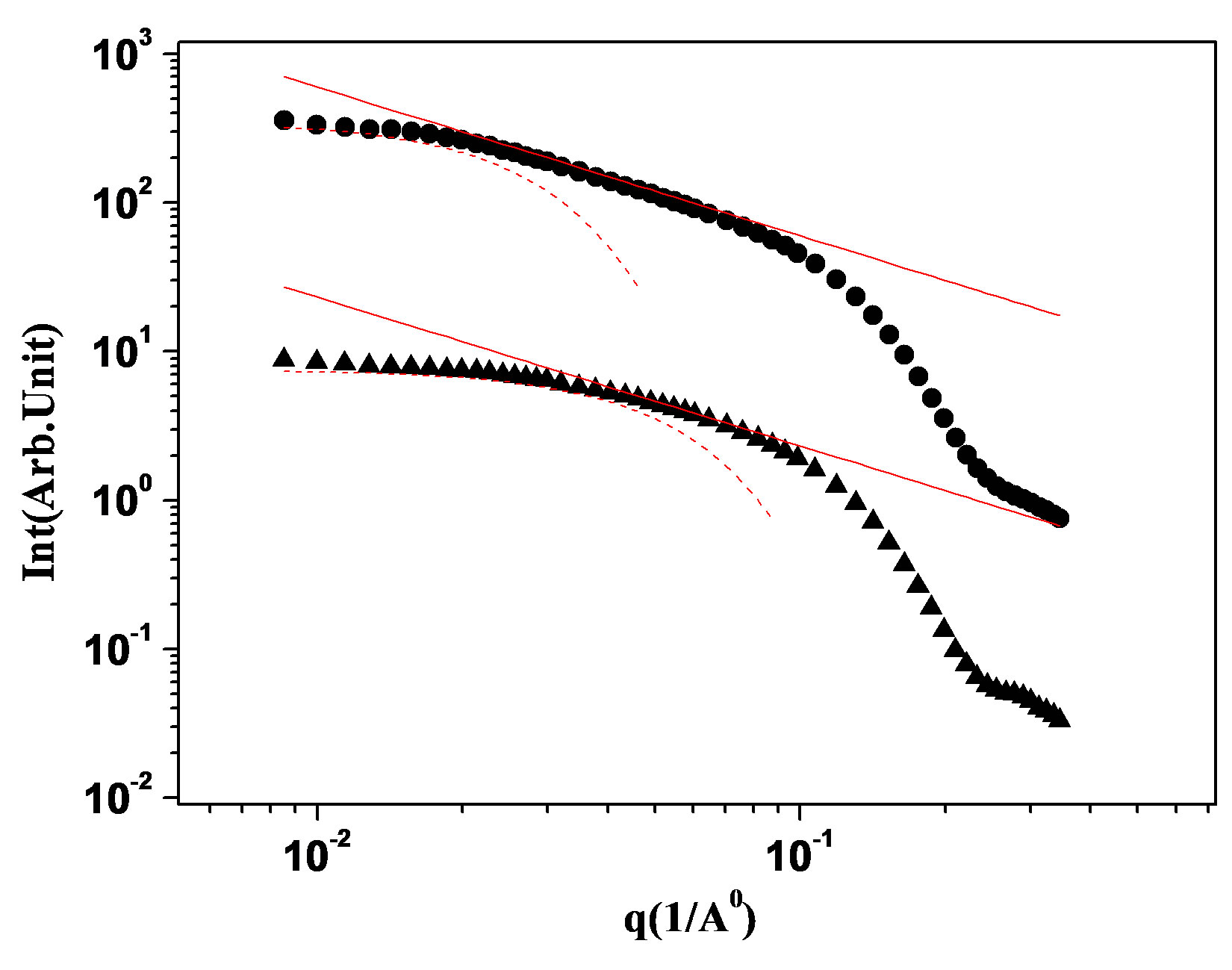
Figure 4. SAXS intensity I(q) of a AOT/H2O/Decane microemulsion (▲up triangle points) with X = 6.7 and droplet mass fraction (mf = 0.1) and AOT/H2O/Decane/NaCl microemulsion (● circle points) with X = 6.7 at constant droplet mass fraction (mf = 0.1) and [NaCl]/[AOT] = 0.005. The red line is the line with slop (−1) that shown cylinder behavior of the SAXS experiments and dot line at low q is the fit of Guinier’s law, I(q) ≈ exp(−(qξ)2/3) and ξ change from 50 Å to 30 Å with adding NaCl at 20˚C.
overall dimension of the scattering particles, and we analyzing with Guinier’s law, I(q) ≈ exp(−(qξ)2/3), where ξ is a correlation length.
The correlation length was changed from 60 Å to 30 Å with adding NaCl to the AOT/H2O/Decane microemulsion, figure 4. The change in the correlation length of microemulsion can increase the collective diffusion coefficient of droplets. For analyzing the data, we applied a model for a mixture of core-shell spheres with an added depletion attraction due to dissolved non-adsorbing polymer. The scattering intensity as a function of scattering vector I(q) of spherical Monodisperse particles can be describe with a form factor component F(q), which is proportional to the scattering of a single particle, and a structure factor S(q), which describes the interaction effect [15,16]:
 (2)
(2)
c being a prefactor, which contains density of scattering particles. For the general case of n shells around a spherical droplet core the form factor reads.
 (3)
(3)
Where Ri is the radius of the ith shell or, respectively, the core R0 and ∆ρi is the electron density contrast between the shells i and I + 1 with ρn+1 and ρ0 being the electron density of the solvent and the core, respectively. The structure factor is the Fourier transform of the pair correlation function g(r).
 (4)
(4)
The pair correlation function gives the probability to find another particle at a distance r from the center of a given particle, relative to the probability to find a particle at this distance in an ideal gas.
It is closely related to the total correlation function h(r) = g(r) −1 and it can by means of the Ornstein-Zernike equation [17,18]. The figure 5 shows the compare of the SAXS experiment with the results of the hard sphere model, the points are experiments data of SAXS and the red lines are hard sphere model with core-shell radius 30nm. This results show that AOT/H2O/Decane/NaCl microemulsion at X = 6.7 and mf = 0.1 isn’t hard sphere and more similar to cylinder shape. The increase of the NaCl to the microemulsion decrease the length scale of
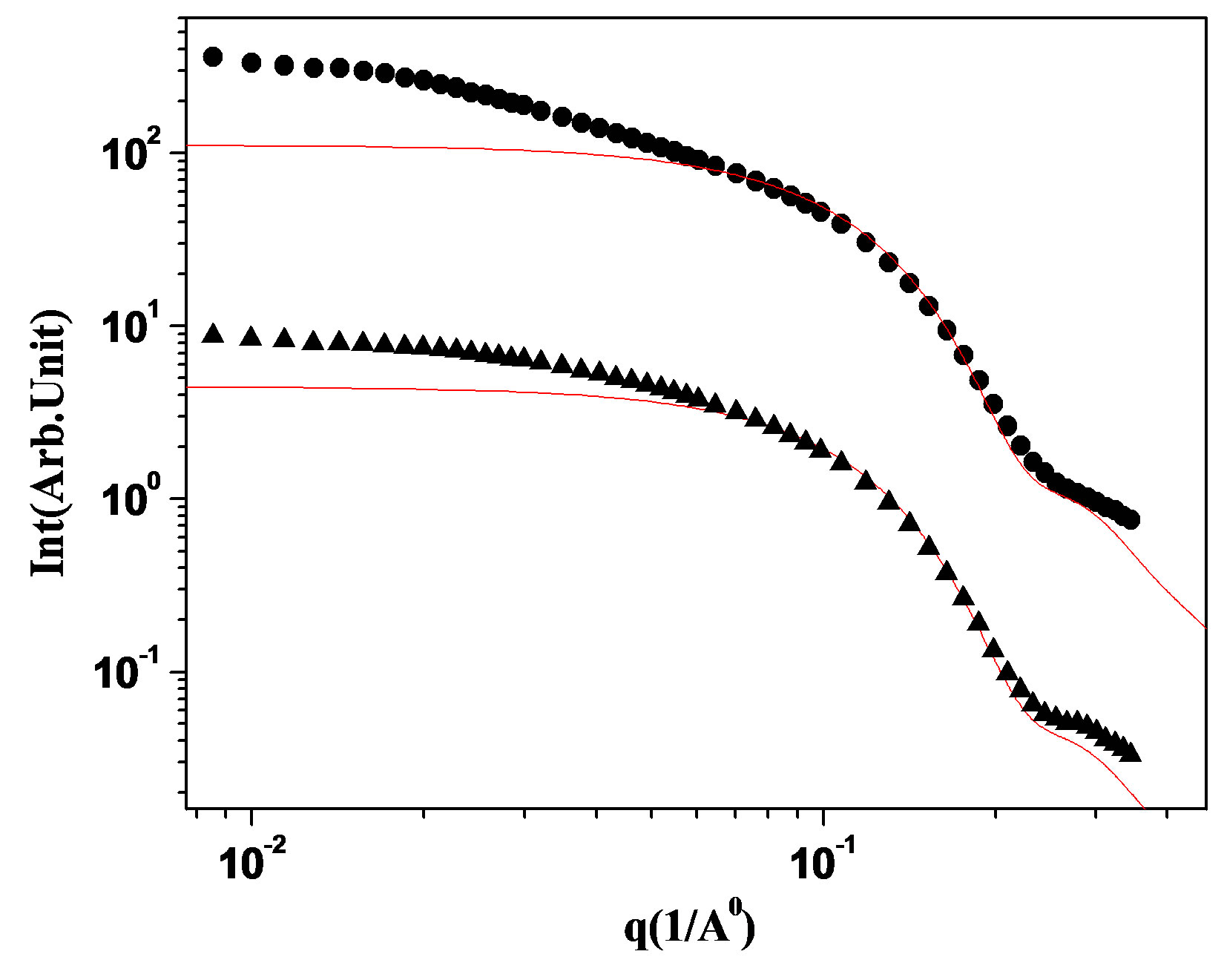
Figure 5. SAXS intensity I(q) of a AOT/H2O/Decane microemulsion (▲up triangle points) with X = 6.7 and droplet mass fraction (mf = 0.1) and AOT/H2O/Decane/NaCl microemulsion (■cubic points) with X = 6.7 at constant droplet mass fraction (mf = 0.1) and [NaCl]/[AOT] = 0.005 at temperature 20˚C. The red line is the hard sphere with core shell model with the core radius 25 nm, core-shell radius 30 nm.
the cylinder and droplets become more similar to the sphere. So, the NaCl can change the cylindrical AOT/ H2O/Decane microemulsion to the spherical microemulsion.
Our results show that the length scale of the droplet changes from 60 Å to 30 Å and shape of droplets changed from spherical to cylindrical by increasing the mass fraction. The study of the C12E5 microemulsion at different droplet mass fraction shows a repulsive behavior that with increase of concentration of PEG on the C12E5 microemulsion, system become attractive [19,20]. In the AOT microemulsion, the collective diffusion coefficient shows a negative slop at mass fraction and so shows a attractive interaction that with add NaCl the interaction stay attractive.
4. Conclusion
The study of the collective diffusion coefficients of AOT/ H2O/decane microemulsions showed a negative slope as a function of droplet mass fraction at the low mass fraction. Small-angle X-ray scattering measurements revealed that AOT microemulsions show cylinder behavior at X = 6.7 and mass fraction 0.1. The NaCl can change the shape of nano-droplets from cylindrical to the spherical and the shape changing of nano-droplets can describe the increasing of collective diffusion coefficient as a function of the mass fractions.
5. Acknowledgements
This work was supported by the University of Sistan and Baluchestan.
REFERENCES
- P. Kumar and K. L. Mittal, “Handbook of Microemulsion Science and Technology,” Marcel Dekker, New York.
- L. K. Pershing, L. D. Lambert and K. Knutson, “Mechanism of Ethanol-Enhanced Estradiol Permeation across Human Skin in Vivo,” Pharmaceutical Research, Vol. 7, No. 2, 1990, pp. 170-175. doi:10.1023/A:1015832903398
- P. Liu, T. Kurihara-Bergstrom and W. R. Good, “Cotransport of Estradiol and Ethanol through Human Skin in Vitro: Understanding the Permeant/Enhancer Flux Relationship,” Pharmaceutical Research, Vol. 8, No. 7, 1991, pp. 938-944. doi:10.1023/A:1015876117627
- Y.-H. Kim, A.-H. Ghanem, H. Mahmoud and W. I. Higuchi, “Short Chain Alkanols as Transport Enhancers for Lipophilic and Polar/Ionic Permeants in Hairless Mouse Skin: Mechanism(s) of Action,” International Journal of Pharmaceutics, Vol. 80, No. 1-3, 1992, pp. 17-31. doi:10.1016/0378-5173(92)90258-4
- S. Sharifi, M. Amirkhani, J. M. Asla and M. R. Mohammadi and O. Marti, “Light Scattering and SAXS Study of AOT Microemulsion at Low Size Droplet,” Soft Nanoscience Letters, Vol. 2, No. 1, 2012, pp. 76-80. doi:10.4236/snl.2012.21002
- S. N. Tenjarla, “Microemulsions: An Overview and Pharmaceutical Applications,” Critical Reviews in Therapeutic Drug Carrier System, Vol. 16, 1999, pp. 461-521.
- W. Brown, (Ed.), “Dynamic Light Scattering: The Method and Some Applications,” Clarendon, Oxford, 1993.
- J. Bergenholtz, A. Romagnoli and N. J. Wagner, “Viscosity, Microstructure, and Interparticle Potential of AOT/ H2O/n-Decane Inverse Microemulsions,” Langmuir, Vol. 11, No. 5, 1995, pp. 1559-1570. doi:10.1021/la00005a025
- S. Sharifi, P. Kudla, C. L. P. Oliveira, J. S. Pedersen and J. Bergenholtz, “Variations in Structure Explain the Vicometric Behavior of AOT Microemulsions at Low Water/AOT Molar Ratios,” Zeitschrift für Physikalische Chemie, Vol. 226, No. 3, 2012, pp. 1-18. doi:10.1524/zpch.2012.0173
- T. Blochowicz, C. Gögelein, T. Spehr, M. Müller and B. Stühn, “Polymer-Induced Transient Networks in Waterin-Oil Microemulsions Studied by Small-Angle X-Ray and Dynamic Light Scattering,” Physical Review E, Vol. 76, No. 4, 2007, p. 041505. doi:10.1103/PhysRevE.76.041505
- P. N. Pusay, “Intensity Fluctuation Spectroscopy of Charged Brownian Particles: The Coherent Scattering Function,” Journal of Physics A, Vol. 11, No. 1, 1978, p. 119.
- T. Nose and B. Chu, “Static and Dynamical Properties of Polystyrene in Trans-Decalin. 3. Polymer Dimensions in Dilute Solution in the Transition Region,” Macromolecules, Vol. 13, No. 1, 1979, pp. 122-132. doi:10.1021/ma60073a024
- M. Kotlarchyk, S.-H. Chen, J. S. Huang and M. W. Kim, “Structure of Three-Component Microemulsions in the Critical Region Determined by Small-Angle Neutron Scattering,” Physical Review A, Vol. 29, No. 4, 1984, p. 2054. doi:10.1103/PhysRevA.29.2054
- G. R. Deen, C. L. P. Oliveira and J. S. Pedersen, “Phase Behavior and Kinetics of Phase Separation of a Nonionic Microemulsion of C12E5/Water/1-Chlorotetradecane upon a Temperature Quench,” Journal of Physical Chemistry B, Vol. 113, No. 20, 2009, pp. 7138-7146. doi:10.1021/jp808268m
- M. Schwab and B. Stuhn, “Relaxation Phenomena and Development of Structure in a Physically Crosslinked Nonionic Microemulsion Studied by Photon Correlation Spectroscopy and Small Angle X-Ray Scattering,” Journal of Chemical Physics, Vol. 12, No. 14, 2000, pp. 6461- 6471. doi:10.1063/1.481207
- M. Nayeri, M. Zackrisson and J. Bergenholtz, “Scattering Functions of Core-Shell-Structured Hard Spheres with Schulz-Distributed Radii,” Journal of Physical Chemistry B, Vol. 113, No. 14, 2009, pp. 8296-8302. doi:10.1021/jp811482w
- G. Fritz-Popovski, “Determination of Colloidal Interaction Potentials from Small Angle Scattering Data,” Journal of Chemical Physics, Vol. 131, No. 24, 2009, pp. 8296-8302. doi:10.1063/1.3231606
- B. Weyerich, J. Brunner-Popela and O. Glatter, “SmallAngle Scattering of Interacting Particles. II. Generalized Indirect Fourier Transformation under Consideration of the Effective Structure Factor for Polydisperse Systems,” Journal of Chemical Physics, Vol. 32, No. 11, 1999, pp. 197-209. doi:10.1107/S0021889898011790
- S. Sharifi and M. Amirkhani, “Light Scattering Study of Mixture of Polyethylene Glycol with C12E5 Microemulsion,” Soft Nanoscience Letters, Vol. 1, No. 3, 2011, pp. 76-80. doi:10.4236/snl.2011.130144
- S. Sharifi and A. Alavi, “Dynamic Light Scattering Study of Microemulsion,” Proceedings of the SPIE, Vol. 8001, 2011, pp. 80012R-80012R-8. doi:10.1117/12.892990
NOTES
*Corresponding author.

